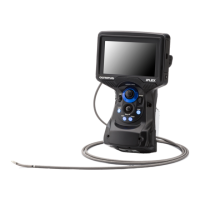90
Chapter 4 Operation
EVIS LUCERA GIF/CF/PCF TYPE 260 Series OPERATION MANUAL
• The endoscopic image may be disrupted while switching
between WLI observation mode and NBI observation mode.
Therefore, do not perform any endoscopic operation or
treatment while switching between the WLI observation
mode and NBI observation mode. Otherwise, injury in the
body cavity may result.
• Set the brightness of the light source to the minimum level
necessary to perform the procedure safely. If the endoscope
is used for a prolonged period at or near maximum light
intensity, vapor may be observed in the endoscopic image.
This is caused by the evaporation of organic material (blood,
moisture in stool, etc.) due to heat generated by the light
guide near the light guide lens. If this vapor continues to
interfere with the examination, remove the endoscope, wipe
the distal end with a lint-free cloth moistened with 70% ethyl
or isopropyl alcohol, reinsert the endoscope, and continue
the examination.
• The color tone and brightness of the NBI observation mode is
different from the WLI observation mode. Use the NBI
observation mode only after fully understanding its features.
• Water may drip from the air/water valve during water feeding
(for GIF-N260 only). However, this is not a failure but a
characteristic of this endoscope. The water dripping from the
air/water valve is clean (i.e., sterile water in the water
container). If water is dripping from the air/water valve, follow
the instructions below.
Inspect the air/water valve, as described in Section 3.3,
“Preparation and inspection of accessories” on page 68. If
you find any scratching or tears in air/water valve’s seals
or other irregularities, replace the air/water valve with a
new one.
Hold control section higher than the water container
during water feeding.
In case continuous water feed is necessary, feed water as
short as possible (shorter than 5 seconds).

